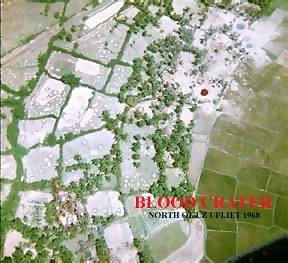THE BLOOD CRATER
by
Marvin Strawn
Introduction
The Blood Crater was a byproduct of a very violent 18-hour battle that took place on May 5-6, 1968 between the 1/50th Mech and a NVA regiment. In its after-action report, the 1/50th refers to this clash as the Battle of An Boa. According to the after-action report, U.S. casualties, KIA and WIA, were over 100. NVA losses must have been much greater because 117 NVA bodies were found on May 6-7. Since almost no weapons were captured, the unarmed “porters” the NVA normally used may have also been on the battlefield to remove dead and wounded. I remember hearing at the time that the regimental HQ had been destroyed and it appeared one of the bodies was that of a Chinese advisor.
I flew command and control for the 1/50th battalion commander, the Silver Fox, fairly frequently and was flying the mission as the battle unfolded with the NVA regiment attacking Co A(-) 1/50th (9 APCs but only around 50 men) north of LZ Uplift just before noon on May 5. We took off from Uplift as soon as the attack was reported with the 1/50th battalion CO, an RTO and forward observer. As we cleared the low mountain range just north of Uplift, we saw 5 APCs on fire and 4 more headed in a northerly direction out of the kill zone. Seventeen Alpha Company soldiers were eventually trapped for an hour or two in rice patties just north of the burning APCs. Many of the U.S. casualties occurred during the rescue of the trapped men. As we arrived at the scene and orbited trying to sort things out, I looked down into a creek line and saw hundreds of NVA scurrying around like ants– forest green uniforms, pith helmets, the real deal.
The next hours were very hectic and the battle was still raging but apparently under control when my C&C ship was relieved around 1800. At the time, I assumed the 1/50th losses must be quite high but the next time I flew for the Fox when I asked, he responded he had lost no one. I imagine he did not want the real losses to be known because I found the 1/50th after-action report on the 50th Mech website in January 2003 and the losses in Co A(-) were over 70% (11 KIA and 26 WIA out of the 50 or so engaged). Total losses for the 1/50th in the battle were 16 KIA and 82 WIA. In addition, the 1/69 Armor had 2 KIA and 9 WIA. I believe there also was at least 1 KIA when a gunship from a unit other than the 61st went down on May 5 although that loss did not appear in the after-action report. 61st gunships were also involved in the opening minutes of the fight and both were shot-up so badly they had to land but we had no injuries. 61st gunship losses also were not reported in the after-action report. In addition to gunships and the C&C ship on May 5-6, the 61st was involved moving troops into blocking position on May 6. The after-action report indicates simply that supporting forces included the 173rd aviation section.
The after-action report and my memory have many more details about the early hours of the battle and the days that followed that I will be happy to share with anyone.
Blood Crater
I first noticed the Blood Crater west of the highway shortly after the battle ended. There were several bomb craters in the area all filled with green soapy-colored water except one; it was blood red. We talked about what might have been hit and one guess was water buffalo. However, after a couple of weeks, the color hadn’t changed much so eventually we assumed whatever was in the crater was not blood. I left Vietnam several months later not knowing what created the blood crater.
Small World
In about 1976, eight years after the battle, while attending a National Guard function in Wisconsin, I was talking with another Vietnam vet. He had been with the 1/50th Mech during the Blood Crater battle. I asked if he had seen the Blood Crater and he surprised me by laughing and saying: “Yeah. I saw it. One of my guys created it. He drove an APC into the bomb crater one night and lost all his transmission fluid trying to get out.”I finally knew then that the “blood” was really the red transmission fluid, the “cherry juice”, floating on the water in the crater.
Smaller World
In 1988, still in the Guard as an artillery officer, I was standing with an Active Duty artillery colonel watching one of my batteries fire at Ft. McCoy, Wisconsin. Seeing my 1st Aviation Brigade patch, the colonel asked about my service. He turned out to have been the Silver Fox’s forward observer and had been on my helicopter that first day of the battle. I asked if he had seen the Blood Crater. He said: “Yeah. Wasn’t that something. I took pictures of it.” Twenty years after the battle, I was able to tell him about the “blood”.
Now almost 35 years after the battle, any 61st guys that remember the Blood Crater and care, know what I know.[1]

[1] The photograph that accompanies this account was originally a slide taken with a simple instamatic camera. The colors had a strong magenta hue to them so I enhanced them with Photo Shop Elements to make the crater would stand out better. However, the red of the crater is no more red than I remember it.
